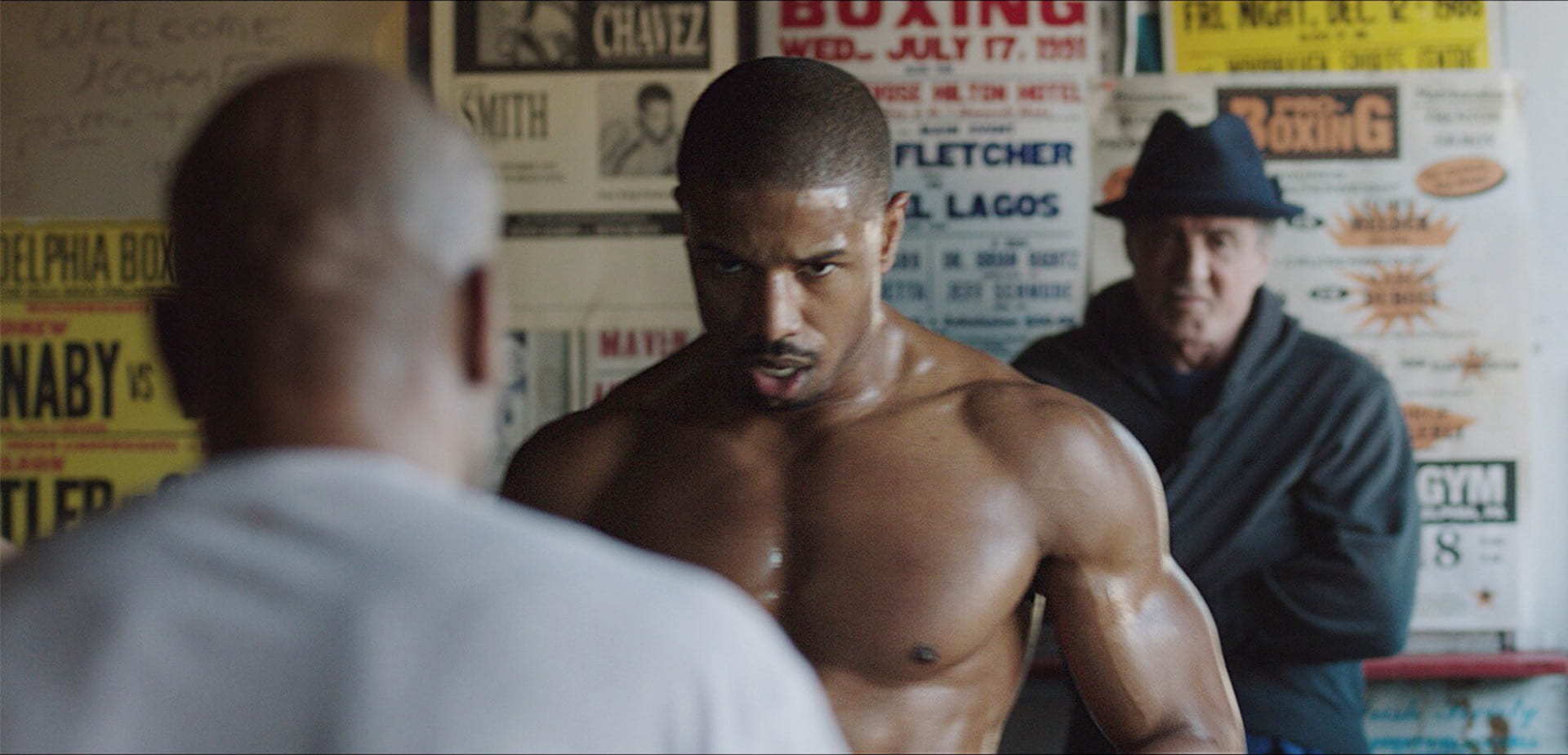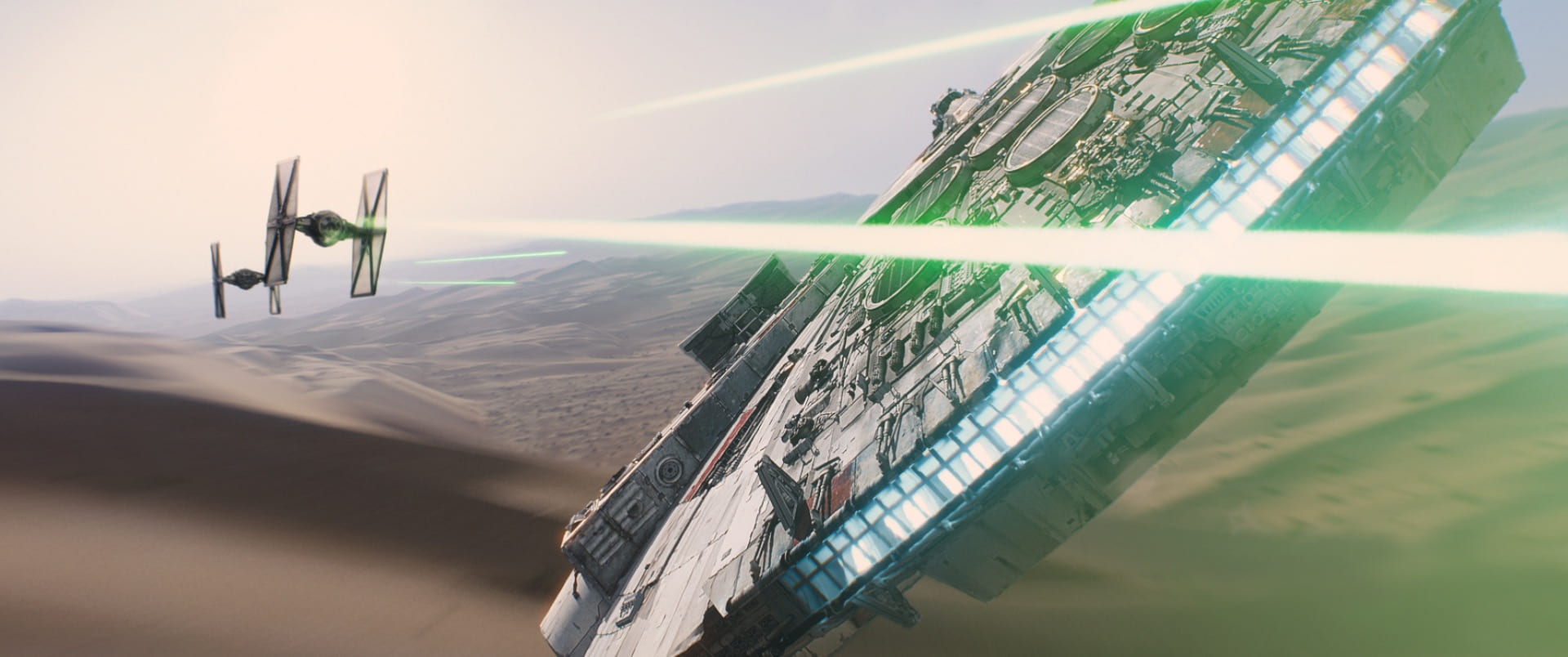
Rocky and Adonis Creed prepare to fight in Creed
Legacyquels most frequently appear within genre franchises. Indeed, the only legacyquel I have found that doesn’t fit into the sci-fi, horror, action, sports, or romance genres is Symbiopsychotaxiplasm: Take 2½, a sequel to the first film with the same name made 35+ years prior to its release in 2005. William Greaves’ films deliberately eschew genre and filmmaking mode boundaries, mixing documentary and fiction, romance and social revolution. Nearly every other legacyquel-bearing series/franchise can be painted with some broad genre brush, from Star Wars to Rocky/Creed and the Before series, each film slots neatly into a genre category that can be listed on a streaming service’s platform.
As films in a series rarely shift genres and legacyquels even more rarely change this element, being sold as a continuation of a thing audiences loved some time ago returning triumphantly to the big screen, the genre aspect of a legacyquel trailer becomes a two-part sales technique. First, it reminds the viewer familiar with the series what specific genre pleasures can be had within this series of films as an enticement to return when the film debuts. Secondly, it shows a newer, updated vision of the generic world contained within the original film as a promise to new audiences that this film will be just as visually rewarding as the other films within this genre released at this time. The balance between reminding audiences of the past, promising more of that, and ensuring those unfamiliar with the series that it will not be an outdated dinosaur of a movie (with the exception of the Jurassic Park/World series, of course) is crucial to the advertising of the legacyquel film.
While makers of traditional sequel trailers can rest relatively sure that the audience is in fact anticipating a new entry in a series that is ongoing, legacyquel trailer makers face a different set of audience expectations altogether. Kernan asserts that “The rhetorical logic of sequel and cycle trailers entails a textual demonstration of the producers’ knowledge that audiences liked the original film by asserting in the sequel trailer their desire to make another one like it, which in turn creates an assumption that audiences will want to come to see the latest episode or version since they are assumed to have liked the first one.”[i] While this may be true of traditional sequel trailers, the legacyquel trailer must first remind audiences of why they went to see the original films in the first place and reignite any passion they might have for the series. One of their biggest tools for such a reignition is the generic world that was originally crafted in the prior entries in the series.
The Force Awakens’s teaser trailer accomplishes this task while featuring very little dialogue outside of a voiceover by an unknown (but seemingly evil based on intonation and, in the full film, revealed to be the villainous Snoke) person talking about “an awakening,” asking (audiences) “Have you felt it?” This short bit of dialogue plays out over images of each of the new protagonists in familiar locations. There’s Finn in his stormtrooper uniform—sans helmet—popping up in a desert reminiscent of the first film’s Tatooine, Rey in a similar locale but with a floating bike reminiscent of Luke’s speeder in A New Hope, BB-8 traversing what seems like a shipyard, Poe in an X-Wing cockpit decked out in a very familiar Rebel uniform, and Kylo Ren walking into a snow-filled forest before igniting a red lightsaber indicating he’s going to be a villain. The final “character” who gets an introduction in this brief trailer is the Millennium Falcon, the disc-shaped ship that the heroes of the first films flew around the galaxy far, far away. We not only see this familiar sight but hear the familiar sound of the Falcon’s whining engines as well, ensuring audiences that this is the same old ship they’ve grown to know intimately over the course of the prior entries in the series. But it is not only the ship who is returning based on this trailer, it is the world of Star Wars that is being reasserted here.
Kernan suggest that “the most obvious way that many trailers invoke specific genres is through iconography. Those trailers with strong genre appeals will often underline familiar generic iconography by presenting it in hyperbolic fashion.” When the film is part of a series that genre appeal through iconography can be even more directly tuned to a series appeal. The specific genre pleasures associated with the prior entries in the series are revisited in legacyquel trailers to remind audiences of what they enjoyed about the original film(s)’s take on the genre in question. Star Wars famously rethought science fiction to emphasize its real-world grime and disrepair while exoticizing space travel as a journey between planets with giant, singular biomes (desert, swamp, forest, etc.), traits that seem to carry over in this teaser for the series’ first legacyquel entry alongside the more obvious iconography of the lightsaber, ship designs, and even John Williams’ score playing over all of these familiar image.
This Star Wars teaser, however, also fulfills the other genre expectation based on the desires of audiences unfamiliar with the series to see a film based in a certain genre and providing the kinds of pleasures they expect to see in films of that genre in their contemporary moment. It is unlikely that even audiences unfamiliar with the original Star Wars films would be entirely ignorant of the series iconography, so stuff like the lightsabers and Millennium Falcon would probably perform some kind of signification even for these newer audiences being courted by this trailer. But more important is how they are deployed.

Kylo Ren and Rey fight with lightsabers in The Force Awakens
Everything in this trailer is dynamically shot to achieve maximum effect. Part of this comes from director JJ Abrams’ distinctive visual style which emphasizes alacrity in both action and performance. No stormtrooper had ever popped up into the frame the way Finn does in the trailer’s first shot (nor have they ever had their helmets off). Rey’s hoverbike is shot from near ground level and in a quick pan that calls attention to the speed of her driving. BB-8 is a ball and thus rolls swiftly along the bumpy desert ground it is traversing while whistle-and-booping in an echo of R2-D2’s mode of communication even as the trailer asserts this is a new evolution of droid given its speed. The shot of Poe’s X-Wing (and the other two accompanying him) shakes vertically as if the camera capturing the footage is strapped to an equally fast ship. Kylo Ren’s lightsaber is unlike any other, rattling with almost uncontainable energy and featuring two exhaust vents that give it a look more like European swords than the katanas the original sabers were based on.
And, perhaps most importantly, we do not get an introduction to the Falcon in a typical flying situation. Instead, the shot we see of the Falcon is perhaps the most visually dynamic shot of the entire series as it follows the ship while it does a near-planet loop and skims along the surface of the desert we’ve seen throughout the trailer. The original Star Wars films, as groundbreaking and impressive as they were for their recreation of WWII-film-influenced ship battles rather than the relatively staid naval-warfare-influenced Star Trek battles, were simply unable to capture such visual dynamism in their ship-based action scenes. In the time between 1977 and the release of this trailer in 2014, CGI had become the dominant force in special effects rather than the miniatures that were primarily used in the original trilogy. The Star Wars prequels featured faster and more dynamic action scenes thanks to their CGI, but those were still formally locked down in ways that retained their status as homage to the WWII plane battles Lucas was originally inspired by. In other words, those space battles happened faster and featured more dynamic movement but weren’t filmed much differently than the battles in the original trilogy.

The Millennium Falcon flies at TIE Fighters in The Force Awakens
However, Abrams brought to the series a perspective inspired not by WWII films but by the videogames made about those prequel trilogy films, particularly the Rogue Squadron games that placed players in cockpits of the series’ ships for fast-paced dogfights and space battles. Offering first-person, in-cockpit views and third-person, behind-the-ship perspectives to play from, the games were well-reviewed for finally capturing the feeling of piloting these ships and giving players a unique, dynamic experience of these ships more intimate than any seen in the preceding films. So when Abrams, influenced by these games and the news coverage of modern warfare that featured on-the-ground filmed footage that also inspired takes on space fighting like those seen in the Battlestar Galactica tv show with its quick zooms and “handheld” imitation, directed the action and the placement of the CG “camera” within these ship action scenes he did so more freely and in such a way as to highlight the incredible agility, speed, and acrobatic nature of the ships and those piloting them. This is this trailer’s greatest appeal to new fans: our space action is going to be next level stuff. It will fit into (and exceed) your expectations for a sci-fi action film and a Star Wars film at the same time.
[i] Ibid., 50.